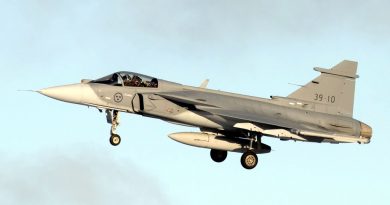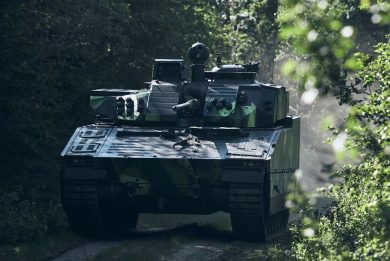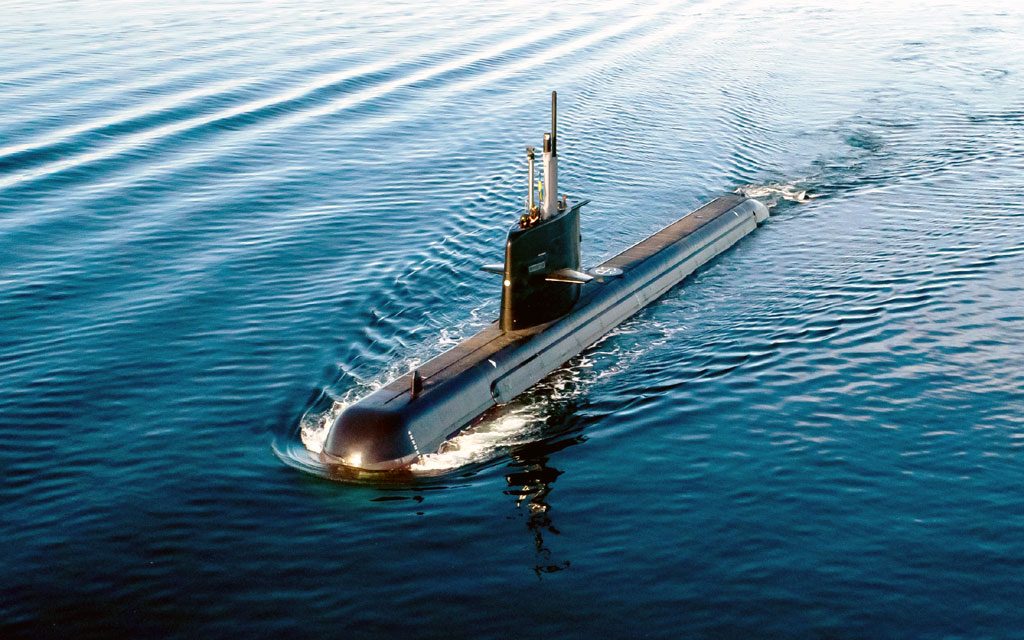
Saab Kockums maintains the edge
By Luca Peruzzi
“Saab has (always) recognized the value of submarines and hidden operations. With the introduction of the new-generation Blekinge-class submarines (as the A26 underwater platform has been named by the King of Sweden) and the introduction of the Multi-Mission Portal (MMP), Saab brings a new versatility to the submarine world”, said Gunnar Wieslander, head of Saab business area Kockums, and previously a submariner which headed the Swedish Navy’s underwater force, introducing the latest Saab submarine on-line seminar.
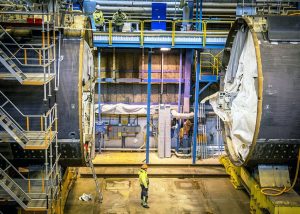 Highlighting the main and latest developments, know-how and technologies which Saab Kockums is introducing with the A26 family of submarines and the Gotland-class mid-life update, the company’s seminar remarked the importance and the efforts being placed in the sector, not only to support the national customer but also looking to the international market with a next-generation family of platforms built around the A26 programme. Saab is currently involved in the Polish and Dutch tenders and is following the market development in the Asia-Pacific region, as acknowledged by the head of the group’s business area Kockums.
Highlighting the main and latest developments, know-how and technologies which Saab Kockums is introducing with the A26 family of submarines and the Gotland-class mid-life update, the company’s seminar remarked the importance and the efforts being placed in the sector, not only to support the national customer but also looking to the international market with a next-generation family of platforms built around the A26 programme. Saab is currently involved in the Polish and Dutch tenders and is following the market development in the Asia-Pacific region, as acknowledged by the head of the group’s business area Kockums.
“Five years after the acquisition of Kockums shipyard (in 2014), Saab has delivered the first (of two) upgraded Gotland-class to the Defence Materiel Administration (FMV), the Blekinge-class submarines are being built and the shipyard in Karlskrona has gone through a fundamental reshaping”, said the head of Saab business area Kockums, introducing the main theme of the seminar.
The Kockums shipyard has a long heritage, tradition and skill in producing submarines for the Swedish Navy having built seven classes of underwater platforms and conducted a series of mid-life upgrading programmes to keep the submarines at their edge. Rickard Jonnason, project owner for the Mid-Life Upgrade of the Gotland-class submarines, highlighted the importance of this programme for enhancing the capabilities of a submarine class that entered in service in 1996, “cutting it and introducing a new hull module lengthening the overall platform together with the replacing of 20 different types of aging systems with new generation equipment”. The upgraded Gotland first-of-class submarine was relaunched in June 2018, followed by the second-of-class Uppland one year later on last June.
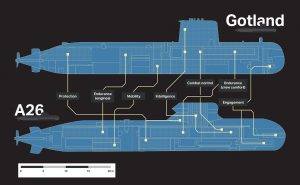 The first part of the answer to show how Saab continues maintaining the edge in the underwater platform domain is the modular design, said Jonnason. Through evolutionary steps, Saab developed key capabilities such as the Stirling AIP, which was first introduced on the Nacken-class in 1998 as a circa 10-meters new added module. Today the system has been introduced in its fourth iteration with enhanced capabilities on the upgraded Gotland-class boats and will be in service with the A26. The AIP isn’t the only system which will be also embarked on the A26 as the 20 new generation systems will also find accommodation on the Blekinge-class, “in this way the MLU Gotland programme acts as an important risk reduction and learning exercise for the A26 programme”, said Jonnason. Many of Saab Kockums’ system engineers have been effectively ‘shared’ across the two programmes, ena bling their knowledge and experience to bear on both. The same applies to the upgraded Gotland-class crews that can support the new Blekinge-class personnel training and skill-development.
The first part of the answer to show how Saab continues maintaining the edge in the underwater platform domain is the modular design, said Jonnason. Through evolutionary steps, Saab developed key capabilities such as the Stirling AIP, which was first introduced on the Nacken-class in 1998 as a circa 10-meters new added module. Today the system has been introduced in its fourth iteration with enhanced capabilities on the upgraded Gotland-class boats and will be in service with the A26. The AIP isn’t the only system which will be also embarked on the A26 as the 20 new generation systems will also find accommodation on the Blekinge-class, “in this way the MLU Gotland programme acts as an important risk reduction and learning exercise for the A26 programme”, said Jonnason. Many of Saab Kockums’ system engineers have been effectively ‘shared’ across the two programmes, ena bling their knowledge and experience to bear on both. The same applies to the upgraded Gotland-class crews that can support the new Blekinge-class personnel training and skill-development.
 The latest development in modularity with the A26 has been highlighted by Anna Gandal, head of Mechanical Systems at Kockums, who provided an overview of the largest of the three members of the A26 family, the Oceanic ER (Extended Range) that can satisfy the different requirements of demanding navies. With hydrodynamics limiting the length in each of the three segment – Pelagic model with less of 50 meters, Oceanic model with a 65 meters length and the Oceanic ER with over 80 meters, the latter with an over 3,000 tonnes displacement surface comes in nine main hull modules.
The latest development in modularity with the A26 has been highlighted by Anna Gandal, head of Mechanical Systems at Kockums, who provided an overview of the largest of the three members of the A26 family, the Oceanic ER (Extended Range) that can satisfy the different requirements of demanding navies. With hydrodynamics limiting the length in each of the three segment – Pelagic model with less of 50 meters, Oceanic model with a 65 meters length and the Oceanic ER with over 80 meters, the latter with an over 3,000 tonnes displacement surface comes in nine main hull modules.
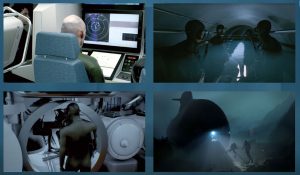 “We prepare our boat design to be able to accommodate different modules both with new production as well as during mid-life upgrades”, said the Saab representative. Among the hull modules and capabilities offered by the A26 Oceanic ER model we find the AIP, the vertical launching system for anti-ship and cruise missile modules, as well as the Multi-Mission Portal (MMP) for special forces operation. The latter is a circa 1.5 meters diameter multi-mission portal, located between two pairs of 533 mm torpedo tubes, which permits the deployment of divers and unmanned underwater vehicles. The portal which according to previously released information, is 6 meters in length, can lock-in/lock-out up to eight divers at a time.
“We prepare our boat design to be able to accommodate different modules both with new production as well as during mid-life upgrades”, said the Saab representative. Among the hull modules and capabilities offered by the A26 Oceanic ER model we find the AIP, the vertical launching system for anti-ship and cruise missile modules, as well as the Multi-Mission Portal (MMP) for special forces operation. The latter is a circa 1.5 meters diameter multi-mission portal, located between two pairs of 533 mm torpedo tubes, which permits the deployment of divers and unmanned underwater vehicles. The portal which according to previously released information, is 6 meters in length, can lock-in/lock-out up to eight divers at a time.
Such a capability in building oceanic submarines comes from a completed reshaped and state-of-the art shipyard in Karlskrona as explained by Helena Lönegard, head of production at Kockums. Saab has introduced leading technologies in the latter facility that allow Sweden to be part of the few submarine builder nations around the world.
Looking to on-going and future programmes, Gunnar Wieslander, head of Saab business area Kockums has elaborated Kockums participation in the Netherlands tender, saying that the contenders are waiting news by the end of 2019. Saab Kockums has been working in exclusive partnership with Damen Schelde Naval Shipbuilding in proposing a tailored Walrus-class submarine replacement platform based on the Oceanic ER model as a co-development where the pressure hull sections would be built in Sweden and outfitted and integrated in the Netherlands, involving and exploiting the engineering and industrial expertise through the Dutch Underwater Knowledge Centre (DUKC) cluster of enterprises. The head of Saab Kockums business area also provided some details of the offer to the Polish MoD for the Orka programme. Although Wieslander hasn’t elaborated on the programme status, the Polish MoD requirement would be initially met by Swedish FMV with the delivery of Sodermanland-class submarines waiting the construction of the A26 platform that is being offered as the replacement solution to current aging Kobben- and Kilo-class boats.
Photos and viewgraphs courtesy Saab Kockums


